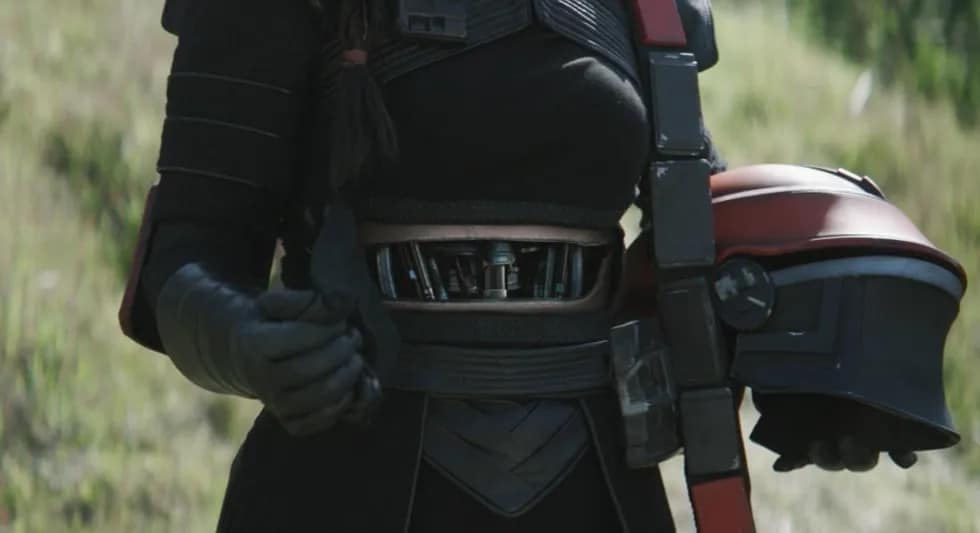In 1839 Edgar Allen Poe published a short story, The Man That Was Used Up.
The story’s main character is General John A.B.C. Smith, who us modern readers will just imagine is John Cena. Smith is an impressive physical specimen who is called “one of the most remarkable men of the age.” Smith is known for his great speaking ability and is six feet tall with broad shoulders, as well as a host of other essentially perfect attributes.
Everyone wants to learn more about this heroic man, but his servants don’t want to speak about the General when asked, and instead only speak to the achievements of the “inventive age.” With a simple perception check, readers understand that some secret is being hidden.
So, when then story cuts to the General’s home, readers are asked to visualize a pile of strange items on the floor. But like a Gibbering Mouther, the pile begins to speak in the voice of the General. Piece by piece his servants begin to assemble him – a leg screwed on, a glass eye plopped in, a tongue placed into his mouth, a wig atop his head.

The General had been captured and severely mutilated by Native American warriors. He hadn’t only lost the battle, he had literally lost pieces of himself, pieces that became artificial prostheses that must be put on every morning in order for the General to appear perfect and ideal in public.
Readers now understood the General’s secret.
Edgar Allen Poe’s original story cost a measly twelve and a half cents, so the world of science fiction certainly got their value. With The Man That Was Used Up, Edgar Allen Poe set up two science fiction tropes that largely persist to this day:
- Cybernetics can bring forth the human ideal.
- Cybernetics are shameful and meant to be hidden.
In other words, cybernetics in popular culture are often portrayed as simultaneously grotesque and desirable.
Among 1000s of other examples of cybernetics in popular culture has been the villainous Dr. No in the Bond films, the gifted engineer Geordi LaForge of Star Trek fame, the cartoonish Mr. Gadget, the ultra violent RoboCop, the playboy billionaire Tony Stark, the iconic Darth Vader, and the undeniably alluring Six from Battlestar Galactica. Many of these cyborgs have played straight to tropes, while others subverted or reimagined them.
But for the rest of this article, I want to talk about cybernetics in The Book of Boba Fett.
Cyborgs and Cybernetics: The Book of Boba Fett
Boba Fett hires a gang of aimless youths to be his foot soldiers. They ride ridiculous speeders that look like Parisian Vespas. In what was supposed to be an action sequence, they looked like future Biff from Back to the Future 2 as they engaged in the most slow-motion chase seen in the history of cinema.
But what was most interesting is that each of them had physical modifications. One a bionic arm, another a cybernetic eye, and others all sorts of modifications they paid money to receive in a “mod shop” just outside Mos Espa.
They weren’t the only Book of Boba Fett characters to visit the mod shop. Mandalorian viewers remember that the assassin Fennec Shand was left to die of a gut shot but Boba Fett found her. What Book of Boba Fett showed is she was only saved because Fett took her to the mod shot and she was able to receive extensive cybernetic to replace her failed internal organs.
Boba Fett asked for the unconscious Fennec to be sewn up but the “surgeon” was aghast that anyone would ever attempt to conceal a modification. But when Fennec finally came to, her first reaction was shock and she gasped, “What did you do to me?!?!”
Later, Boba Fett apologized for a remark toward one of the youth’s cybernetic eye. Without batting a lash, the youth responded, “I’m proud of my eye. I paid good money for it.”
So, times have changed it seems since the days of Edgar Allen Poe. Culture can no longer assume that cybernetics are shameful and that the DNA-infused God-given flesh we are born with is more ideal than synthetic bells and whistles.
Indeed, times have changed. In Edgar Allen Poe’s day there wasn’t the tattooing, dying, and piercing that we see today. There wasn’t gender reconstruction surgeries. Nor were there any sort of prosthetics beyond false teeth, hook hands, or peg legs.
Nowadays, it’s not too hard to imagine today’s tattoo parlors becoming mod shops when the tech is there. And it’s nothing short of a miracle of science that medical technology is allowing more and more prosthetics that are allowing the disabled to walk, use their hands, see again, and much more. It’s wonderful.
Star Wars has always sprinkled in cybernetics in their storytelling. Darth Vader was an enigma when he first appeared in Star Wars in 1977, but from the outset they teased the fact he was as much machine as man. Darth Vader clearly had cybernetic enhancements, most of which added to his overall frightening appearance.
Boba Fett was even more of an enigma, the viewers never getting much inclination there was anything human beneath that t-shaped visor. We heard a voice, sure, but only a few lines, so although we knew Fett was human and not a droid, we also saw ample evidence that the man was awash in tech.
First, Star Wars has become a defining example of pop culture, so it is meaningful that it fits very well within the cybernetics tradition. Boba Fett has a gunslinger vibe. Droids dialed tech up to 11 and introduced an AI vibe. The concept of bacta tanks highlighted tech and flesh in a really “fluid” environment.
All that added up to Star Wars having a “subtle familiarity” while also being able to be wholly unique and twisted toward a new expression of cybernetics. A paramilitary-looking lineup of mercenaries bent on financial self-interest via bounty hunting was full of tropes where cybernetics fit perfectly.
Secondly, Star Wars harkened back to the tropes expressed by Edgar Allen Poe. Darth Vader had some suped-up s&!† going on that was mixed with some woo woo wizardry that placed him at the pinnacle of human power, yet there was something monstrous and grotesque about him all the while.
Luke Skywalker grew into a “force” to be revoked with and his cybernetic hand enhancements became part of his persona. We saw something similar in The Book of Boba Fett with Fennec Shand being taken to a “mod shop.”
But just like humans fear power they don’t understand, humans also fear things that don’t look the way that is expected, so the cybermetrically-modified come across as very off-putting in their appearance. Sure, the tech upgrades might make them “peak” human, but it’s at the expense of not appearing quite human. Edgar Allen Poe would have been proud of the subtle infusion of cybernetics in Star Wars storylines.
Thirdly, the cybernetically-modified often extort their power over others, bringing out the real human fears about cybernetics. Much like Olympic doping, cybernetics is almost universally seen as unfair by other humans who don’t like to see an uncompetitive advantage expressed by a small few who they see as “souped up.”
The Mob Shoppers of Tatooine manipulate this subconscious fear as they use their cybernetics to form a gang that could have easily devolved into unorganized crime and violence if not given a job by Boba Fett to partake in organized crime and violence. This is the cybernetic future that us gen-pop humans fear: a world taken over by crazies with chips implanted in their brains. Well, that’s the fear my grandma always expressed anyway.
Cyborgs and Cybernetics in Popular Culture, From Edgar Allen Poe to Fennec Shand
So, Star Wars clearly drew inspiration from the sci-fi cybernetics tropes introduced by Edgar Allen Poe. And now the realities of today are both advancing those tropes even as they also turn them on their side.
Why have cybernetics been written about by Poe and drawn in comic books? Do we secretly fear we’ll lose our humanity, becoming one of “those.” Do we secretly lust for the power that could come through artificial enhancement of our bodies?
I don’t know. But I do know that cybernetics has a rich tradition in popular culture. Cyborgs with tricked out components are a part of so many of the nerdy stories, games, and movies we love. But I don’t think most of us have stopped to contemplate just why cybernetics sink their wires into our psyches so deeply.


